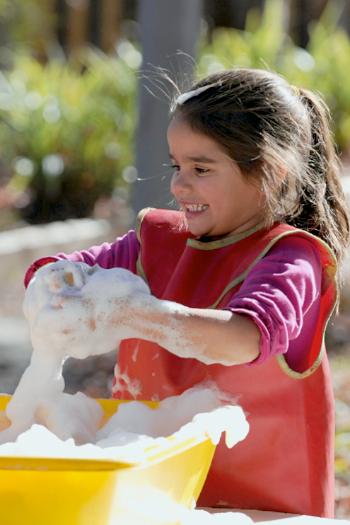Trickle, drip, splash
Duration/age

All you need is a container, some water and some things to play with. Half fill a plastic tub, the bathroom sink or even a baby bath with water. Choose a few different containers and sit with your child and play together. Talk about what is happening as you measure, pour and gently splash.
How many of those cups does it take to fill the teapot? What about these little bottles?
Can you squeeze all the water out of the sponge?
Oh, no - we got wet!
Materials you will need
- Plastic jugs and cups of different sizes
- Small plastic bottles
- Sponges
- Funnels
- Small plastic or metal teapot
- Yoghurt tubs
- Plastic containers
- Plastic tub or baby bath
- Bathroom sink
Skills this activity improves
Why does this matter?
Water play is a great way to learn about volume and measurement. Children can estimate and begin to learn about measurements, such as how many cups it takes to fill a jug.
Children will learn to count and use number words and words relating to capacity and volume.
They are also using both small and large muscles and developing eye-hand coordination as they play.
What does this lead to?
This helps children to understand the mathematical concepts that are used in everyday life. For example, pouring the water and measuring will help children to recognise how much to pour into a cup and when to slow down ready to stop pouring.
Both large and small muscle control, and eye hand are important for writing.
Language to use
- Full, empty, half full, nearly full
- Pour, spill, overflow
- Heavy, light
- Tip, lift, carry
- Trickle, drip, splash
- Cup, jug, tub
- Sponge, squeeze
- Wet, dry
Questions to use
- How can you fill up the big jug? Can you pour the water out again?
- How does it feel when it is full? Can you lift it? What about when it is empty?
- Which one is heavier? Which one is lighter?
Useful tips
- You might like to put an old towel down so that it doesn't get too slippery.
- You might also like to take a look at the activities Textured water play and Pouring a drink.
- For safety information visit www.parenting.sa.gov.au.
- Remember to talk to your child in your home language.
More ideas
- Colour the water with some food colouring.
- In cooler weather you could use warm water for this activity.
Variation by age
Birth to two year olds
- Add water toys like cups and jugs to bath time.
- Wash your toys. You could bathe your dolls or make a car wash for your toy cars.
Three to five year olds
- Make froth and bubbles by adding some dishwashing liquid to the water. Use egg beaters and whisks to make the froth. The froth is fun to pour and measure too.
- Floating and sinking. Add some light and heavy things to the water play. Try and predict which ones will float and which will sink.
- Make a floating picture. Float flowers, leaves, petals or feathers in a shallow bowl of water to make pictures.
Questions to use
- Can you pour the water out of the jug? Can you pour it over your head?
- How high can your pour it? Does it make the same sound when you pour it down low or up high? Trickle? Drip? Splash!
Questions to use
- How many bubbles can we make?
- Can you pour the bubbles with a jug?
- Do you think this rock will float or sink? What about this big feather?
- Can you make a pattern with these flowers? Which one do you like the best?
Language to use
- Wash, scrub, rinse
- Wet, dry, towel dry
Language to use
- Froth, bubbles
- Whisk, stir
- Scoop, pour
- Float, sink, submerge
- Big, small, flat
- Leaf, petal, flower
- Inside, outside, edge, middle


